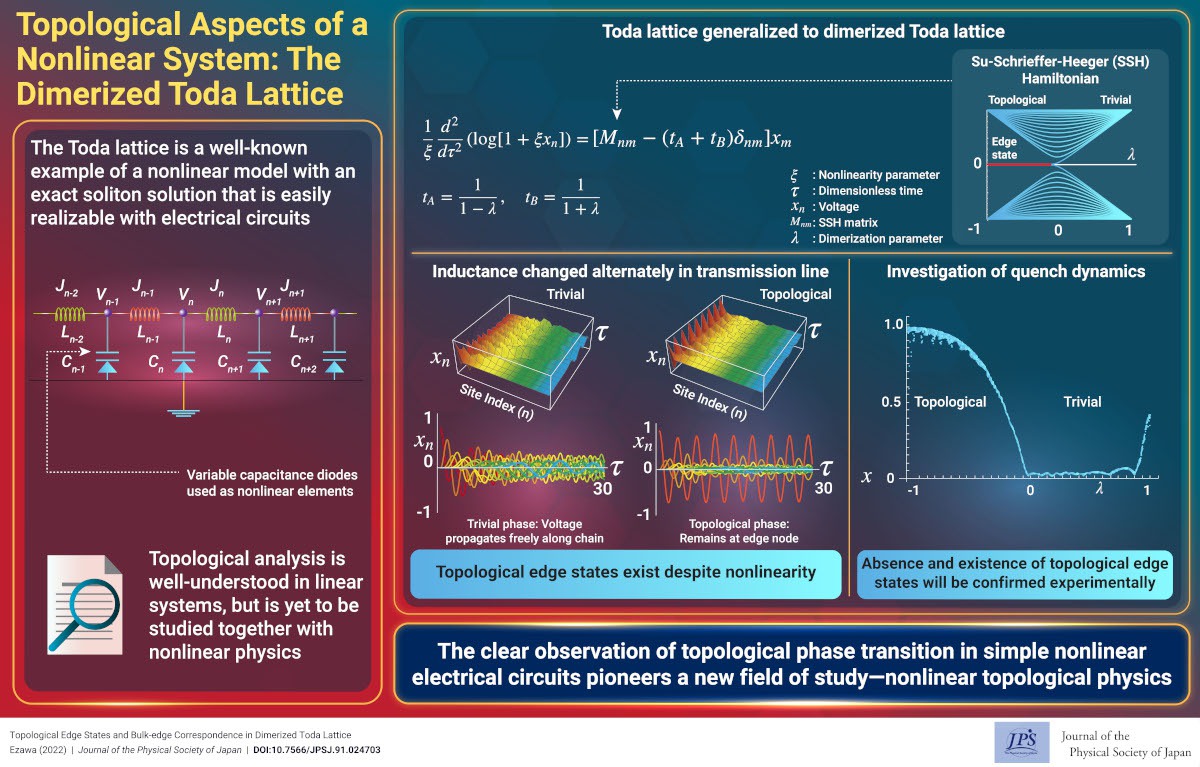Topological Aspects of a Nonlinear System: The Dimerized Toda Lattice
© The Physical Society of Japan
This article is on
Topological Edge States and Bulk-edge Correspondence in Dimerized Toda Lattice
(JPSJ Editors' Choice)
J. Phys. Soc. Jpn.
91,
024703
(2022)
.
A nonlinear topological phase is shown to emerge in the dimerized Toda lattice. It is experimentally detectable by measuring the voltage propagation in electric circuits.

Nonlinear physics is an extensively studied field that is highlighted by the emergence of solitons and chaos. A soliton is a solitary wave that is stabilized by the nonlinear term. It is originally proposed in the surface wave of water and then found in various systems. The Toda lattice is a typical nonlinear model possessing an exact soliton solution. It is experimentally realized in a transmission line consisting of inductors and variable-capacitance diodes, where the variable-capacitance diodes provide the nonlinear elements. A stable voltage propagation was observed in this transmission line. In contrast, the topological physics is an emerging field, where characteristic topological edge states emerge in the topological phase. The Su–Schrieffer–Heeger (SSH) model is the simplest example of a topological insulator, where the bonds are alternating. To date, nonlinear and topological physics were studied independently. It is an interesting problem to study a nonlinear topological physics, which will open a new field of physics.
We generalize the Toda lattice to a dimerized Toda lattice as in the case of the SSH model. We show that this model is realized by changing the inductance alternately in the transmission line realizing the Toda lattice. This model has topological edge states although it is a nonlinear model. We verify it by investigating the quench dynamics, where we apply a voltage at the edge node and explore its time evolution. The voltage propagates freely along the chain in the trivial phase, whereas it remains at the edge node in the topological phase. Hence, the absence and the existence of the topological edge states are well signaled by the voltage propagation dynamics. Thus, nonlinear topological physics will be relatively easily realized and studied experimentally in electric circuits. This result will open a new field of nonlinear topological physics.
(Written by M. Ezawa)
Topological Edge States and Bulk-edge Correspondence in Dimerized Toda Lattice
(JPSJ Editors' Choice)
J. Phys. Soc. Jpn.
91,
024703
(2022)
.
Share this topic
Fields
Related Articles
-
Higher-Order Topological Phases in Magnetic Materials with Breathing Pyrochlore Structures
Electronic structure and electrical properties of surfaces and nanostructures
Magnetic properties in condensed matter
Mathematical methods, classical and quantum physics, relativity, gravitation, numerical simulation, computational modeling
2025-4-7
A simple example of a higher-order topological phase, in which the symmetry decreases step-by-step from the bulk to the corner, is realized in a magnetic system with a pyrochlore structure and is characterized by a series of quantized Berry phases defined for the bulk, surface, and edge.
-
A Unified Theory of Topological Hall Effect
Electronic transport in condensed matter
2025-3-6
This paper presents a unified theoretical description for the topological Hall effect, covering the entire region from strong- to weak-coupling, extending its picture beyond the Berry phase.
-
Excitonic Insulators: Challenges in Realizing a Theoretically Predicted State of Matter
Electron states in condensed matter
Electronic transport in condensed matter
2025-3-3
The realization of an excitonic insulator can help in the establishment of a new electronic state in condensed matter physics, one that has the potential to exhibit novel electric, magnetic, and optical responses beyond those of conventional materials.
-
Triangular Lattice Magnet GdGa2: Spin Cycloids and Skyrmions
Cross-disciplinary physics and related areas of science and technology
Electronic transport in condensed matter
Magnetic properties in condensed matter
2025-2-3
Careful measurements were conducted on the hexagonal magnet GdGa2 to reveal the experimental signatures of ultrasmall spin cycloids and of a potential Néel-type skyrmion lattice phase induced by a magnetic field.
-
Shaping the Future of Materials Science with Tanabe–Sugano Diagrams
Dielectric, optical, and other properties in condensed matter
Electron states in condensed matter
Electronic structure and electrical properties of surfaces and nanostructures
Magnetic properties in condensed matter
2025-1-21
This special collection published in the Journal of the Physical Society of Japan celebrates 70 Years of Tanabe–Sugano Diagrams, highlighting their continued role in advancing materials with transition metals.




